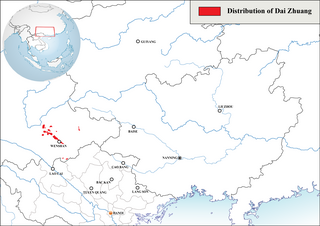
Phongsali or Phongsaly is the capital of Phongsaly Province, Laos. It is the northernmost provincial capital in Laos, opposite Attapeu in the south. The town has about 8,000 inhabitants. It lies at approximately 1,430 meters elevation on the slopes of Mount Phu Fa. Phongsali has summer temperatures around 25-30 °C, with frequent rain. In winter, from November to March, it is cool and mostly sunny, with daytime temperatures between 10-18 °C.

Luang Namtha is a district as well as the capital of Luang Namtha Province in northern Laos. The city lies on the Tha River.
Akha is the language spoken by the Akha people of southern China, eastern Burma, northern Laos, and northern Thailand.
Bit is an Austroasiatic language spoken by around 2,000 people in Phongsaly Province, northern Laos and in Mengla County, Yunnan, China.

Dai Zhuang or Thu Lao is a Tai language spoken in Yunnan, China and northern Vietnam. In China is it spoken in Yanshan, Wenshan, Maguan, Malipo, Guangnan counties of Wenshan Prefecture. It is also spoken in Honghe Prefecture. The largest concentrations are in Wenshan and Yanshan counties.
The Southern Loloish or Southern Ngwi languages, also known as the Hanoish (Hanish) languages, constitute a branch of the Loloish languages that includes Akha and Hani.
Phunoi (Sinsali) is a Loloish language of northern Laos. Dialects are divergent and may be distinct languages; these are Black Khoany, White Khoany, Mung, Hwethom, Khaskhong. Bradley cites six languages within Phunoi.
Bisu is a Loloish language of Thailand, with a couple thousand speakers in China. Varieties are Bisu proper (Mbisu) and Laomian (Guba), considered by Pelkey to be distinct languages.
Chepya is a Southern Loloish language of northern Laos.
Phanaʼ is a Loloish language of Laos and China. Phanaʼ is spoken by 500 people in Laos. In China, it is spoken in Mengla County, Yunnan Province. It is closely related to Sila, which is spoken by 2,000 people in Laos and Vietnam. Badenoch reports that it is similar to.

Phongsaly province, also spelled Phôngsali, is a province of Laos in the extreme north of the country. The capital of the province is the city of Phôngsali. Phongsaly is between Yunnan (China), and Điện Biên province in Vietnam. Its culture has thus been historically heavily influenced by China.
The Yang people, also known as the Nhang or Nyang, are a Tai-speaking ethnic group of Phongsaly Province, northwestern Laos. Chazee (1998) reports that they number 5,843 people as of 2015. The Yang are heavily influenced by Tai Lue culture, although the Yang of Namo Nua village, Oudomxay province are more heavily influenced by Tai Dam people culture.
Phongku is a Loloish language of Phongsaly Province, northern Laos. David Bradley (2007) lists as the autonym.
Laoseng is a Loloish language of northern Laos. David Bradley (2007) lists law21 sɛŋ21 as the autonym.
Phongset is a Loloish language of Phongsaly Province, northern Laos.
Laopan is a Loloish language of northern Laos. It is spoken in Bun Tay District, Phongsaly Province, Laos, including in Phaophumuang village.
Theen is an Austroasiatic language of Laos, belonging to the branch of Khmuic languages. It is only spoken by about 200 people living in two villages. They are also known as Kha Sam Liam among their Lao neighbours.
The Bisoid (Phunoi) languages belong to the Southern Loloish (Hanoish) branch of the Sino-Tibetan language family. Most Bisoid languages are spoken in Phongsaly Province, northern Laos, with smaller numbers of speakers living in China (Yunnan), Vietnam, Myanmar, and northern Thailand.
Wanyä is a Loloish language of northern Laos. It is spoken in Ipoeching village, Bun Tay District, Phongsaly Province.
The Siloid languages belong to the Southern Loloish (Hanoish) branch of the Sino-Tibetan language family. The Siloid branch was first proposed by Hsiu (2016).


